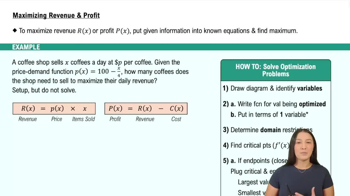Table of contents
- 0. Functions7h 52m
- Introduction to Functions16m
- Piecewise Functions10m
- Properties of Functions9m
- Common Functions1h 8m
- Transformations5m
- Combining Functions27m
- Exponent rules32m
- Exponential Functions28m
- Logarithmic Functions24m
- Properties of Logarithms34m
- Exponential & Logarithmic Equations35m
- Introduction to Trigonometric Functions38m
- Graphs of Trigonometric Functions44m
- Trigonometric Identities47m
- Inverse Trigonometric Functions48m
- 1. Limits and Continuity2h 2m
- 2. Intro to Derivatives1h 33m
- 3. Techniques of Differentiation3h 18m
- 4. Applications of Derivatives2h 38m
- 5. Graphical Applications of Derivatives6h 2m
- 6. Derivatives of Inverse, Exponential, & Logarithmic Functions2h 37m
- 7. Antiderivatives & Indefinite Integrals1h 26m
- 8. Definite Integrals4h 44m
- 9. Graphical Applications of Integrals2h 27m
- 10. Physics Applications of Integrals 2h 22m
5. Graphical Applications of Derivatives
Applied Optimization
Problem 4.5.68
Textbook Question
Cylinder and cones (Putnam Exam 1938) Right circular cones of height h and radius r are attached to each end of a right circular cylinder of height h and radius r, forming a double-pointed object. For a given surface area A, what are the dimensions r and h that maximize the volume of the object?
 Verified step by step guidance
Verified step by step guidance1
First, understand the problem: We have a double-pointed object consisting of a cylinder and two cones. We need to find the dimensions (radius r and height h) that maximize the volume given a fixed surface area A.
Calculate the surface area of the object: The surface area includes the lateral surface area of the cylinder and the lateral surface areas of the two cones. The formula for the surface area of the cylinder is 2πrh, and for each cone, it is πr√(r² + h²). Therefore, the total surface area is A = 2πrh + 2πr√(r² + h²).
Calculate the volume of the object: The volume includes the volume of the cylinder and the volumes of the two cones. The formula for the volume of the cylinder is πr²h, and for each cone, it is (1/3)πr²h. Therefore, the total volume is V = πr²h + 2(1/3)πr²h = (5/3)πr²h.
Set up the optimization problem: We need to maximize the volume V = (5/3)πr²h subject to the constraint that the surface area A = 2πrh + 2πr√(r² + h²) is constant. Use the method of Lagrange multipliers to solve this constrained optimization problem.
Solve the system of equations obtained from the Lagrange multipliers: Differentiate the volume and surface area equations with respect to r and h, set up the Lagrange function, and solve the resulting equations to find the values of r and h that maximize the volume.
 Verified video answer for a similar problem:
Verified video answer for a similar problem:This video solution was recommended by our tutors as helpful for the problem above
Video duration:
7mPlay a video:
Was this helpful?
Key Concepts
Here are the essential concepts you must grasp in order to answer the question correctly.
Surface Area and Volume Formulas
To solve the problem, one must understand the formulas for the surface area and volume of the geometric shapes involved: the cylinder and the cones. The surface area of the cylinder is given by 2πrh + 2πr², while the volume is V = πr²h for the cylinder and V = (1/3)πr²h for each cone. These formulas are essential for setting up the optimization problem.
Recommended video:

Example 1: Minimizing Surface Area
Optimization Techniques
Optimization involves finding the maximum or minimum values of a function. In this context, we need to maximize the volume of the double-pointed object while adhering to a fixed surface area. Techniques such as the method of Lagrange multipliers or substitution can be employed to find the optimal dimensions by setting up a function to maximize and applying calculus principles.
Recommended video:

Intro to Applied Optimization: Maximizing Area
Calculus of Functions of Multiple Variables
The problem requires understanding how to work with functions of multiple variables, specifically the volume as a function of both radius r and height h. This involves partial derivatives to find critical points and determine maxima or minima, as well as constraints that arise from the fixed surface area. Mastery of these concepts is crucial for effectively solving the optimization problem.
Recommended video:

Fundamental Theorem of Calculus Part 1

 1:13m
1:13mWatch next
Master Intro to Applied Optimization: Maximizing Area with a bite sized video explanation from Callie
Start learningRelated Videos
Related Practice







